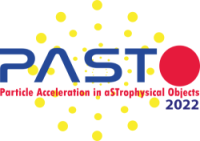Speaker
Description
Magnetic reconnection is a powerful acceleration mechanism since it can impulsively deliver energy that was accumulated for long times and in large volumes. The promptly available energy is stored in magnetic fields produced by current sheets, i.e. antiparallel fields at the two sides of the sheet, with a null in between.
The sudden onset of reconnection events poses the so-called trigger problem: most reconnection theories consider strongly unstable plasmas, but how can such plasmas survive along the path to strong instability conditions? Laboratory experiments indicate that weakly unstable plasmas evolve to fast reconnection by super-exponential growth [1], due to non-linear instability evolution or to detonation effects.
The key condition for acceleration is reconnection efficiency, i.e. the plasma inflow (towards the current sheet) velocity normalized to the Alfvén velocity. The scaling problem deals with efficiency dependence on plasma characteristics. Efficiencies in the 0.03-0.1 range have been found for collisionless plasmas, and theoretical explanations for these results have recently emerged [2].
How delivered energy is distributed among bulk plasma acceleration, thermal heating and acceleration of high-energy tails is sometimes called the equipartition problem. It has been shown that the presence of a “guide” magnetic field along perpendicular to the reconnecting field can impede tail acceleration as it modifies particle orbits.
Another important aspect of magnetic reconnection is plasma reconfiguration, in particular the generation of toroidal currents from driven axial currents, in the absence of any toroidal electric field. This aspect is presently being investigated in the PROTO-SPHERA experiment.
The main concepts and problems of magnetic reconnection will be illustrated in the talk, and recent progress will be reviewed.
[1] P Buratti et al 2003 Plasma Phys. Control. Fusion 45 L9
[2] YH Liu et al 2022 Commun Phys 5, 97
| Collaboration | Plasma@Lab4Space |
|---|

